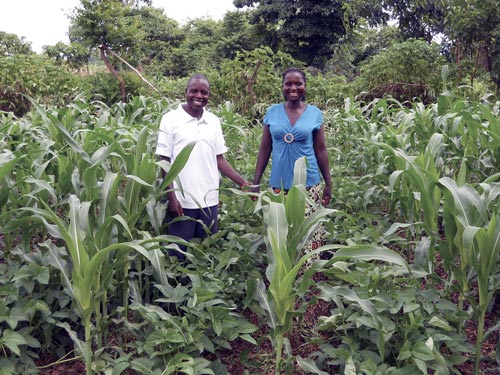The Food and Agriculture Organization of the United Nations (FAO) has tasked CIMMYT with a new project to introduce green manure cover crops to smallholder farmers in eastern Zambia and central and southern Malawi.
Green manures can improve fertility, protect soils and provide fodder and grain for farm animals and humans. They also help substitute for mineral fertilizers, which are costly for landlocked African nations to produce or import. Most smallholder farmers cannot afford them and apply less than 10 kg per hectare of fertilizer to their crops, according to a 2013 study on profitable and sustainable nutrient management systems for eastern and southern African smallholder farming systems.
“This is less than one-tenth of average fertilizer rates in prosperous countries and a key reason why maize yields in southern Africa are around only one ton per hectare,” said Christian Thierfelder, CIMMYT conservation agriculture specialist based in southern Africa. “As a result, many farm families in the region remain food insecure and caught in a seemingly unbreakable cycle of poverty.”

With full participation of farmers, the project will test green manures in rotation with maize and as intercrops or relay crops in different farming systems, according to Thierfelder.
“Improved, high-yielding maize can show its potential only under good agronomic practices, such as optimal plant spacing, timely planting, good weed and pest control and adequate fertilization,” Thierfelder explained. “Farmers in Europe and the Americas have followed these basic principles for generations, and some of the ideas spread to Asia and Africa during the Green Revolution. But in Africa mineral fertilizers are most often used by rich farmers and for high-value crops.“
“Improved maize that tolerates drought and other stresses, coupled with conservation agriculture practices –minimum soil disturbance, crop residue retention and diversification through rotations and intercropping systems – are farmers’ best bet to escape the poverty trap,” Thierfelder said.
Keeping crop residues on the soil is a critical component of conservation agriculture, but the residues are traditionally fed to livestock, which also underpin smallholder farmers’ livelihoods. So the use of conservation agriculture hinges on the ability of a cropping system to produce enough biomass to feed farm animals while providing an adequate residue cover. This requires a source of fertilization to feed the cropping system.
The FAO-CIMMYT project will address this by allocating green manure cover crops for different uses. “Over the last five years, CIMMYT’s global conservation agriculture program has identified potential cover crop varieties that fit farmers’ needs,” Thierfelder said. “Velvet bean, lablab, cowpea, sunnhemp or jackbean can provide 10-50 tons per hectare of extra biomass for livestock. They can also leave 50-150 kilograms per hectare of nitrogen in the soil and do not need any additional fertilizer to grow. Finally, lablab and cowpea provide grain that humans can eat.”
One approach Thierfelder promotes is for a farmer to dedicate part of her land to grow maize under conservation agriculture practices, and other areas to sow green manures, nutritional and cash crops that increase soil fertility and household income. “In this way, a farmer can diversify and gradually have money to purchase mineral fertilizer, boost productivity and move out of poverty.”
Green manure cover crops are not new in Africa. Why should they work this time?
According to Thierfelder, there are examples of success in northern Mozambique with CIMMYT’s partner organization CARE International, using lablab and improved germplasm in cassava-based CA systems can increase cassava tuber yields from 4 to 13 tons per hectare, without using additional mineral fertilizer. “In Tanzania, lablab and other green manures are an important part of the cropping system,” he said. “In Zimbabwe, successful experiments with maize and green manures under an ACIAR-funded ZimCLIFFS project also provide hope. The FAO-CIMMYT project will guide the way on integrating green manures cover crops into these farming systems.”
 Climate adaptation and mitigation
Climate adaptation and mitigation 
